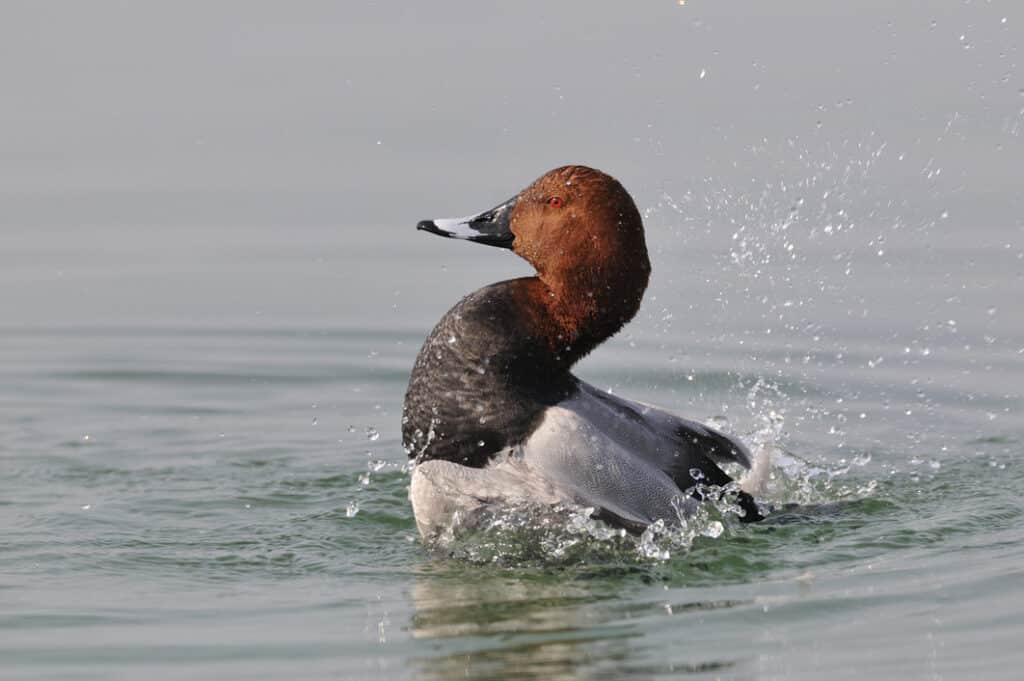Facts about Ducks
At a glance
- Many ducks are sexually dimporphic, males brightly-coloured for display and females often brown so they're inconspicuous when nesting.
- Ducks are unusual in having an 'eclipse' plumage where bright body feathers are replaced by dowdy brown ones.
- Seven duck species can be shot in Britain, including the Red-listed Common Pochard.ease the number of geese species that can be shot.

Of the more than forty species of ducks that have been found in the UK, ten are very rare vagrants (largely arriving from North America), three occur only in winter and another fifteen are far more numerous in winter than summer. The most abundant is the familiar Mallard, with over 100,000 breeding pairs here, its numbers rising to more than 700,000 in winter when birds from northwest Russia, Finland, Sweden and the Baltic states migrate to wintering areas in west Europe and Britain and Ireland.
Most species are sexually dimorphic (females and males look very different: females often patterned so they are inconspicuous when nesting, males much brighter for displaying). Ducks are also unusual in that they moult all their flight feathers at once. For about a month they can’t fly and are very vulnerable to predators. To provide some protection, particularly for the brightly-coloured males, they take on an ‘eclipse’ plumage where bright body feathers are replaced by dowdy brown ones, making them less conspicuous.
Once the flight feathers have regrown they moult again, and by the autumn ducks are back at their very best, with the drakes in fresh plumage.

Which is precisely when shooters start to target them again. The so-called ‘duck shooting season’ runs from the 1st of September to the 31st of January every year.
‘Wildfowlers’ as they like to call themselves largely use shotguns to kill more than half a million reared and wild ducks every year.
Government still allows seven species to be shot: Mallard, Northern Pintail (the fastest-declining dabbling duck in the UK, with the number of wintering birds having halved since 2006), Eurasian Wigeon, Common Teal, Northern Shoveler, Tufted Duck, and Common Pochard (the latter Red-listed as Globally Threatened, because of recent severe winter population decline and recent moderate breeding range decline: in 2019 the EU recommended that the species should be removed from all quarry lists, and as a consequence even the Italian Ministry of the Environment has now given it complete protection). However ducks fly very fast and many look similar when seen from below: shooters are not always skilled at identification, and images of shot ducks on on social media frequently show non-permitted species. A number of vagrant ducks have been killed in modern times including a drake Falcated Duck from East Asia which was shot in Orkney in November 2000.
Most shooting takes place on estuaries at dawn or dusk (shooters love to relate ‘inspiring’ stories about getting up early and how tough it is to stand on a mudflat killing tired ducks as they spiral down to feed) or on lakes which are often stocked with reared Mallards.
Estates charge high sums to kill ducks but place little value on each bird: one advert (placed in the shooting press in 2022) quoted a price for six guns of £840 per gun with a bag size (the number of ducks to be shot) at 250. Rudimentary maths suggest that each shooter will be aiming to kill at least 40 ducks each. Even shooting lobbyists themselves recognise that “Surrounding a relatively small pond, heavily stocked with tame, unfit and overfed birds, to then shoot continuously and indiscriminately until you run out of cartridges, isn’t sport…”
Shooting ‘indiscriminately’ brings us to the indefensible slaughter cause by the punt gun, a massive boat-mounted gun once used to kill enormous numbers of wild duck. Thankfully the excesses of punt gunning (floating out into a river on flat-bottomed boat to unleash mayhem on wintering wildfowl, killing hundreds of ducks in a few shots) is largely dying out now, but stories still surface in the shooting media which glorify it. One breathless author writing in 2021 saw nothing immoral when relating how actor James Robertson Justice (who played Sir Lancelot Spratt in the ‘Doctor in the House’ TV and radio programmes) apparently loved nothing more than punt-gunning on the Dornoch Firth, using ‘Irish Tom’, a14ft long, 300lbs punt gun, which could fire 3lb of lead or the equivalent of 42 twelve-bore cartridges in a single squeeze of the trigger.
Across Europe ducks are being widely impacted by climate change on their breeding and staging areas and have seen huge losses of both estuarine and freshwater habitat. They are still harried by Europe’s so-called ‘hunters’ lining up to shoot them almost every time they land outside a nature reserve though. After long migrations they are greeted by people who later preen themselves as they recount heroic tales of taking the lives of birds that just seconds before were fantastically alive and dazzlingly beautiful.
